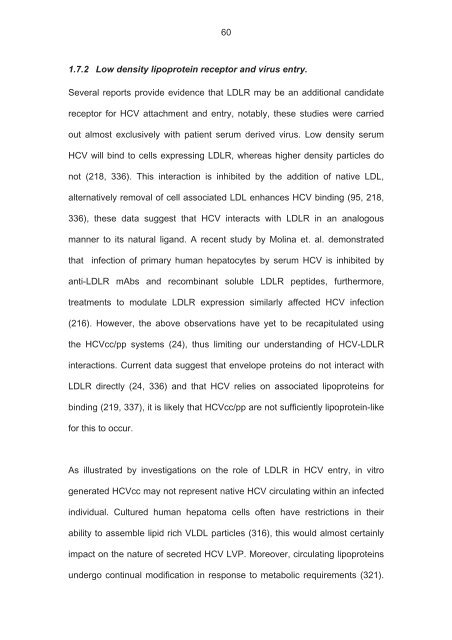The role of scavenger receptor BI in hepatitis - eTheses Repository ...
The role of scavenger receptor BI in hepatitis - eTheses Repository ...
The role of scavenger receptor BI in hepatitis - eTheses Repository ...
Create successful ePaper yourself
Turn your PDF publications into a flip-book with our unique Google optimized e-Paper software.
60<br />
1.7.2 Low density lipoprote<strong>in</strong> <strong>receptor</strong> and virus entry.<br />
Several reports provide evidence that LDLR may be an additional candidate<br />
<strong>receptor</strong> for HCV attachment and entry, notably, these studies were carried<br />
out almost exclusively with patient serum derived virus. Low density serum<br />
HCV will b<strong>in</strong>d to cells express<strong>in</strong>g LDLR, whereas higher density particles do<br />
not (218, 336). This <strong>in</strong>teraction is <strong>in</strong>hibited by the addition <strong>of</strong> native LDL,<br />
alternatively removal <strong>of</strong> cell associated LDL enhances HCV b<strong>in</strong>d<strong>in</strong>g (95, 218,<br />
336), these data suggest that HCV <strong>in</strong>teracts with LDLR <strong>in</strong> an analogous<br />
manner to its natural ligand. A recent study by Mol<strong>in</strong>a et. al. demonstrated<br />
that <strong>in</strong>fection <strong>of</strong> primary human hepatocytes by serum HCV is <strong>in</strong>hibited by<br />
anti-LDLR mAbs and recomb<strong>in</strong>ant soluble LDLR peptides, furthermore,<br />
treatments to modulate LDLR expression similarly affected HCV <strong>in</strong>fection<br />
(216). However, the above observations have yet to be recapitulated us<strong>in</strong>g<br />
the HCVcc/pp systems (24), thus limit<strong>in</strong>g our understand<strong>in</strong>g <strong>of</strong> HCV-LDLR<br />
<strong>in</strong>teractions. Current data suggest that envelope prote<strong>in</strong>s do not <strong>in</strong>teract with<br />
LDLR directly (24, 336) and that HCV relies on associated lipoprote<strong>in</strong>s for<br />
b<strong>in</strong>d<strong>in</strong>g (219, 337), it is likely that HCVcc/pp are not sufficiently lipoprote<strong>in</strong>-like<br />
for this to occur.<br />
As illustrated by <strong>in</strong>vestigations on the <strong>role</strong> <strong>of</strong> LDLR <strong>in</strong> HCV entry, <strong>in</strong> vitro<br />
generated HCVcc may not represent native HCV circulat<strong>in</strong>g with<strong>in</strong> an <strong>in</strong>fected<br />
<strong>in</strong>dividual. Cultured human hepatoma cells <strong>of</strong>ten have restrictions <strong>in</strong> their<br />
ability to assemble lipid rich VLDL particles (316), this would almost certa<strong>in</strong>ly<br />
impact on the nature <strong>of</strong> secreted HCV LVP. Moreover, circulat<strong>in</strong>g lipoprote<strong>in</strong>s<br />
undergo cont<strong>in</strong>ual modification <strong>in</strong> response to metabolic requirements (321).

















